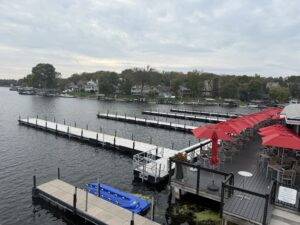As promised – here’s a photo of the new docks at Marina 27. The Lotawana Properties Committee approved their replacement after an inspection revealed broken frame welds; the deck replacement was postponed thanks to repairs. The old docks, originally from the Yacht Club, were donated during their own dock upgrade as we acquired the Grog & Galley property. This project was funded by Lotawana Properties, LLC, which owns the property for the Lake Lotawana Association, Inc. Our lease agreement provides annual investment returns, and a lower mortgage interest rate has helped us both save and reduce principal. Building a reserve for capital projects like dock replacement remains our key goal.
Fall Clean-up Day – Our annual event took place on November 1st and saw another impressive turnout of donations, along with two trash dumpsters and one steel dumpster filled. Many thanks to all the volunteers who supported the event! Special appreciation goes to Dave Williams and his family for again, dedicating the day to collecting Red Rack donations; this season provided many valuable items, resulting in several trailer loads. The LLA supplies dumpsters for clean-up day, and opens the Martin Property for members’ yard waste disposal. Please note: our garbage service allows up to 10 bags of yard waste per week.
Annul Budget Meeting – this edition comes out soon after the annual budget meeting, so I’ll write a summary in the second November edition.
Ditch Cleaning – please be on the lookout for the operations crew along the road as we begin cleaning up the leaves in the ditches around the entire lake. Also, do not blow your yard leaves into the ditches. We clean them out from all the blowing leaves and trees around the road, but are not staffed to pick up everyone’s yard leaves.
Wood Piles – if you are in the need of firewood and can do your own cutting, splitting and hauling we have more than you could ever want at the Martin Property. Just reach out to coordinate access.
Low Water Crossing Update – the box culvert structures are complete with work on the remaining section of roadbed, culvert and dredge pipe construction moving along.
Silt Basin #3 Update – A special thanks to Tyler Reiss who supervised the day to day operations at the Basin coordinating with Dirt World and other contractors hauling off dirt during the project. Gage, Trevor and Larry all put in a lot of hours along with Tyler running the off road dump truck, long arm, excavator and other equipment to accomplish all the dirt removal for the first time since the basin was built.
What they accomplished over the past two years is impressive. In 2024 the crew spent the bulk of the year reshaping the outside of the silt basin from prior year’s dirt removal with Dirt World hauling off the dirt. This year the crew removed approximately 35,000 additional cubic yards the equivalent of almost a million square feet. For example one acre foot volume is 1’ deep x 66’ wide and 660’ long. Our dirt would cover 30 acre feet, which is a swimming pool 1’ deep, 66’ wide and 19,800’ long (3.75 miles). Even with Dirt World and other contractors hauling dirt almost daily we still have over half of the dirt removed staged east of the basin.
To complete the basin renovation project a bid package for the new drain system will be issued soon as we continue to work with third parties to haul all the dirt away. The target is to have the basin #3 project completed and start dredging in 2026 with Quantrill, Waterfall and Big Rock coves. Confidence is high the work will allow all three coves to be dredged without any dirt removal.
Last and very important to our future dredge operation is the development of a very talented group of employees who can operate heavy equipment and get the job done. Could not be prouder of the team!
Deer – this past October there were calls and posts on social media about a Buck standing in the water in the C block area. This type of scene typically means the deer is suffering from Hemorrhagic disease
- Transmission: The disease is not spread by direct contact between deer but through the bite of infected midges. Outbreaks are most common during the hot, dry seasons from July through October. Drought conditions often increase the spread, as deer and midges are concentrated around fewer available water sources. The first hard frost typically ends an outbreak by killing the midges.
- Symptoms: In addition to high fever and a craving for water, signs of HD can include:
- Excessive salivation
- Swelling of the head, neck, and tongue
- Difficulty breathing
- Lethargic, disoriented, or unresponsive behavior
- Lameness or overgrown and cracked hooves in deer that survive the initial infection
- Fatal outcome: The virus can be fatal, and dead deer are often found near or in bodies of water. Some deer survive and develop immunity.
- No human risk: There is no evidence that humans can contract HD, either through handling or eating venison from an infected deer. However, hunters should avoid consuming any animal that appears sick.
Action: Members are requested not to intervene. When the deer passes away, it will sink and re-emerge after several days, at which point the LLA Operations team will manage its removal from the lake. In the event that the animal is a buck and there is interest in harvesting the antlers, permission must be obtained from the Conservation Office prior to proceeding. Additionally, any decision to euthanize a deer requires advance approval and should be done by an experienced hunter.
If you have questions or topics, you would like discussed regarding the Association, please feel free to drop me a note at President@lakelotawana.net.
Sincerely,
Jeff Clemow
President
